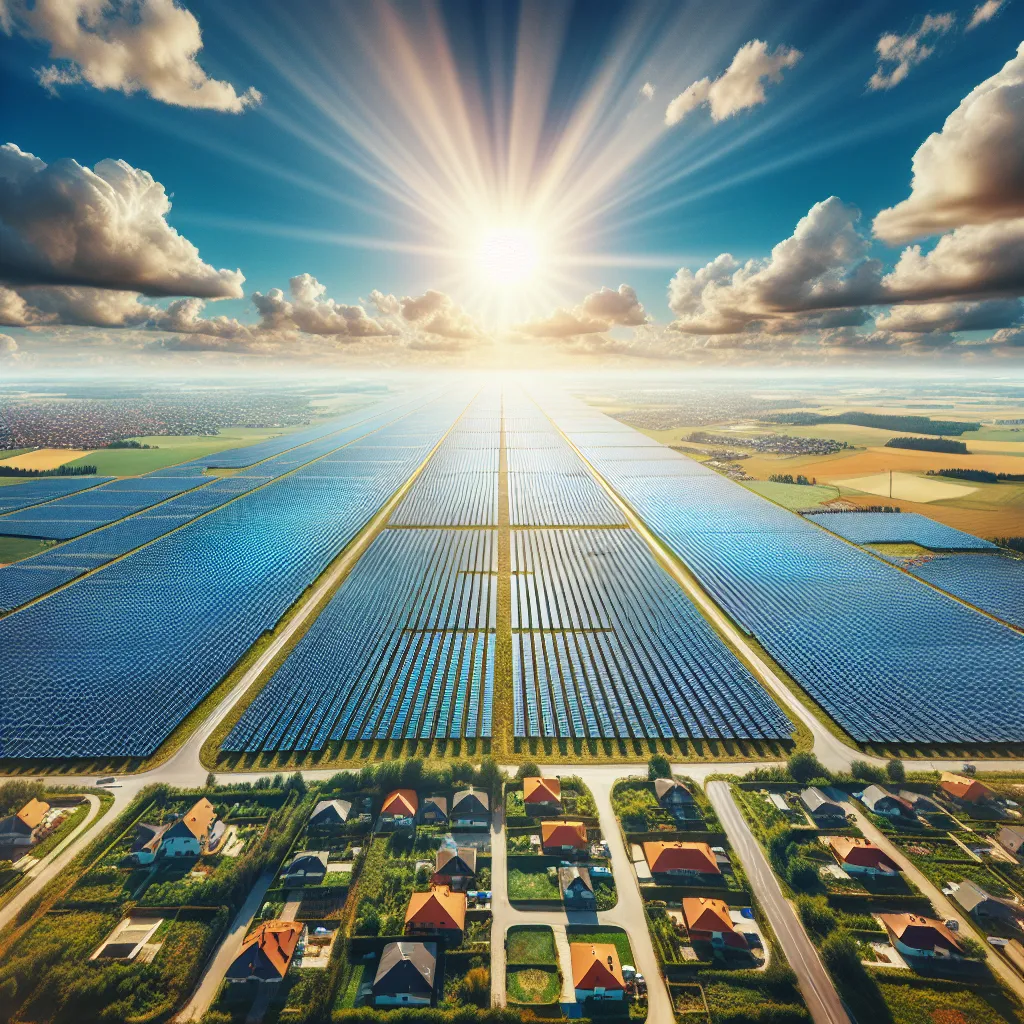Are you preparing for the IELTS Reading test and looking to enhance your skills on topics related to renewable energy and its effects on society? Look no further! This comprehensive practice test will help you tackle questions about “The impact of renewable energy on local communities” while improving your reading comprehension and test-taking strategies.
Introduction to the IELTS Reading Test
The IELTS Reading test is designed to assess your ability to understand and analyze written texts. In this practice test, we’ll focus on the theme of renewable energy and its impact on local communities. This topic is not only relevant for the IELTS exam but also crucial for understanding modern environmental and social issues.
IELTS Reading Practice Test
Passage 1 – Easy Text
The Rise of Renewable Energy in Small Towns
Renewable energy has become a transformative force in many small towns across the globe. Once reliant on traditional fossil fuels, these communities are now embracing clean energy sources such as solar, wind, and biomass. This shift is not just about reducing carbon emissions; it’s reshaping local economies and social structures.
In the rural town of Greenville, for instance, the installation of a wind farm has brought about significant changes. The project created new job opportunities, from construction workers to technicians maintaining the turbines. Local schools have introduced renewable energy courses, preparing the younger generation for future careers in this growing sector.
 wind farm greenville
wind farm greenville
Moreover, the economic benefits are tangible. The wind farm generates revenue through land leases and tax payments, which the town uses to improve public services. This additional income has allowed Greenville to renovate its community center and upgrade the local park, enhancing the quality of life for residents.
The transition to renewable energy has also fostered a sense of pride and environmental stewardship among community members. Many households have installed solar panels, participating in the clean energy movement at a personal level. This grassroots involvement has strengthened community bonds and created a shared vision for a sustainable future.
However, the journey hasn’t been without challenges. Some residents initially expressed concerns about the visual impact of wind turbines on the landscape. The town council addressed these issues through open dialogues and by involving the community in the decision-making process. This collaborative approach has been key to the project’s success and acceptance.
As Greenville’s story spreads, other small towns are taking notice. The renewable energy revolution is not just about technology; it’s about empowering communities to take control of their energy future and, in the process, revitalize their local economies and social fabric.
Questions 1-5
Do the following statements agree with the information given in the passage?
Write:
TRUE if the statement agrees with the information
FALSE if the statement contradicts the information
NOT GIVEN if there is no information on this
- Renewable energy is only focused on reducing carbon emissions in small towns.
- The wind farm in Greenville created job opportunities for local residents.
- Greenville used the revenue from the wind farm to build a new school.
- Some residents were initially concerned about how wind turbines would affect the landscape.
- All small towns have successfully implemented renewable energy projects.
Questions 6-10
Complete the sentences below.
Choose NO MORE THAN TWO WORDS from the passage for each answer.
- The installation of renewable energy sources is ___ local economies and social structures.
- Greenville’s schools have introduced ___ to prepare students for future jobs in renewable energy.
- Many households in Greenville have installed ___ to participate in the clean energy movement.
- The town council used ___ to address residents’ concerns about the wind turbines.
- The renewable energy project in Greenville has created a shared vision for a ___ future.
Passage 2 – Medium Text
Renewable Energy: A Catalyst for Community Development
The proliferation of renewable energy projects in rural and suburban areas has sparked a remarkable transformation in community development. These initiatives, ranging from solar farms to biomass facilities, are not merely technological upgrades but catalysts for comprehensive socio-economic change. The multifaceted impact of these projects extends far beyond the realm of energy production, influencing everything from local job markets to educational systems and community cohesion.
One of the most significant benefits of renewable energy projects is their capacity to stimulate local economies. In regions that have long grappled with economic stagnation, these initiatives inject new life into the job market. The demand for skilled workers in construction, engineering, and maintenance creates a ripple effect, leading to the emergence of specialized training programs and partnerships with educational institutions. For instance, in the town of Sunnydale, the establishment of a large-scale solar farm led to the creation of a renewable energy technician program at the local community college, providing residents with pathways to stable, well-paying careers.
 solar farm sunnydale
solar farm sunnydale
Moreover, the financial influx from these projects often translates into improved public services and infrastructure. Many communities negotiate community benefit agreements with renewable energy developers, securing funds for schools, healthcare facilities, and recreational areas. This symbiotic relationship between energy projects and community development fosters a sense of ownership and pride among residents, who see tangible improvements in their daily lives as a result of these initiatives.
The environmental benefits of renewable energy projects also play a crucial role in reshaping community identity. As towns transition away from fossil fuels, they often rebrand themselves as eco-friendly destinations, attracting environmentally conscious businesses and residents. This shift can lead to a revitalization of local tourism, with communities organizing renewable energy tours and educational programs that showcase their commitment to sustainability.
However, the integration of large-scale renewable energy projects into communities is not without challenges. Issues such as land use changes, potential impacts on wildlife, and alterations to the local landscape can spark controversy. Successful projects typically involve extensive community engagement, transparent communication, and collaborative decision-making processes. Some communities have implemented innovative solutions, such as agrivoltaics, which combine solar energy production with agriculture, maximizing land use and addressing concerns about the loss of farmland.
The social dynamics within communities also evolve with the advent of renewable energy projects. These initiatives often bring together diverse stakeholders, from local government officials to environmental activists and business leaders, fostering new networks and collaborations. Community energy cooperatives, where residents collectively own and manage renewable energy installations, have emerged as a powerful model for democratic energy governance and local empowerment.
As the global push for clean energy intensifies, the experiences of these pioneering communities offer valuable lessons for future projects. The most successful initiatives are those that view renewable energy not just as an environmental solution, but as a tool for holistic community development. By aligning energy transition with local needs and aspirations, these projects are laying the groundwork for resilient, sustainable communities of the future.
Questions 11-14
Choose the correct letter, A, B, C, or D.
-
According to the passage, renewable energy projects in rural areas:
A) Only focus on producing clean energy
B) Have limited impact on local communities
C) Affect various aspects of community life
D) Are mainly beneficial for large cities -
The establishment of a solar farm in Sunnydale resulted in:
A) The closure of the local community college
B) A decrease in job opportunities
C) The creation of a new educational program
D) Immediate economic prosperity for all residents -
Community benefit agreements with renewable energy developers often lead to:
A) Reduced energy costs for all residents
B) Improvements in public services and infrastructure
C) The relocation of local businesses
D) Increased pollution in the area -
The concept of agrivoltaics is mentioned as:
A) A type of renewable energy
B) A solution to land use concerns
C) A new form of agriculture
D) A community engagement strategy
Questions 15-19
Complete the summary below.
Choose NO MORE THAN TWO WORDS from the passage for each answer.
Renewable energy projects have become a driving force for community development, offering benefits beyond clean energy production. These initiatives stimulate local (15) by creating jobs and educational opportunities. Communities often secure funds for public services through (16) with project developers. The transition to renewable energy can lead to communities rebranding themselves as (17) destinations. However, these projects can face challenges related to (18) and environmental concerns. Successful implementation often involves extensive (19)___ and transparent communication with local residents.
Question 20
Choose the correct letter, A, B, C, or D.
- The main idea of the last paragraph is that:
A) Renewable energy projects are always successful
B) Communities should avoid large-scale energy projects
C) Successful projects integrate energy transition with community needs
D) Global push for clean energy is slowing down
Passage 3 – Hard Text
The Nuanced Impact of Renewable Energy on Rural Socioeconomic Structures
The inexorable shift towards renewable energy sources has precipitated a profound transformation in rural landscapes across the globe, engendering a complex web of socioeconomic changes that defy simplistic categorization. While the environmental benefits of this transition are well-documented, the multifaceted impact on rural communities presents a more nuanced picture, replete with both opportunities and challenges that demand careful consideration and adaptive strategies.
At the forefront of this transformation is the reconfiguration of local labor markets. The advent of renewable energy projects, particularly large-scale installations such as wind farms and solar arrays, has introduced a new economic paradigm in areas previously dominated by traditional industries like agriculture or resource extraction. This shift has catalyzed the emergence of novel job categories, ranging from highly specialized roles in engineering and environmental science to more accessible positions in construction and maintenance. However, the distribution of these employment opportunities is often uneven, with a notable dichotomy between short-term construction jobs and the more limited, albeit stable, long-term operational positions.
 renewable energy jobs
renewable energy jobs
The influx of renewable energy projects has also engendered significant changes in land use patterns and property values. In many instances, landowners have benefited from lucrative lease agreements with energy companies, providing a stable income stream that can supplement or even surpass traditional agricultural revenues. This phenomenon has led to a reevaluation of land value in rural areas, with parcels suitable for renewable energy development commanding premium prices. Conversely, this trend has raised concerns about the potential for land use conflicts, particularly in regions where renewable energy projects compete with agricultural production or conservation efforts.
The financial implications of renewable energy projects extend beyond individual landowners to affect the broader fiscal landscape of rural communities. Many localities have experienced a significant boost in their tax base, with renewable energy installations generating substantial property tax revenues. These additional funds have, in some cases, enabled investments in public infrastructure, education, and services that were previously unfeasible. However, the long-term sustainability of this financial windfall remains a point of contention, as the depreciating value of renewable energy assets over time may lead to diminishing returns for local governments.
The social fabric of rural communities has also undergone notable changes in the wake of renewable energy development. The influx of workers, both temporary and permanent, has altered demographic profiles and cultural dynamics in some areas. While this can bring diversity and new perspectives to rural settings, it also presents challenges in terms of social integration and community cohesion. Moreover, the visual impact of large-scale renewable energy installations has sparked debates about rural aesthetics and cultural identity, with some residents viewing these projects as symbols of progress and others as intrusions on traditional landscapes.
The environmental implications of renewable energy projects in rural areas present a complex calculus. While these initiatives contribute to the reduction of greenhouse gas emissions on a macro scale, their local environmental impacts can be more contentious. Issues such as habitat disruption, avian mortality associated with wind turbines, and the use of water resources in certain solar thermal projects have raised concerns among conservationists and local communities alike. Balancing the global benefits of renewable energy with local environmental preservation remains a significant challenge for policymakers and project developers.
The governance and decision-making processes surrounding renewable energy projects have also evolved, often necessitating new forms of community engagement and participatory planning. Successful initiatives have typically involved extensive stakeholder consultation, transparent communication, and mechanisms for local input in project design and implementation. This shift towards more inclusive governance models has, in some instances, empowered rural communities to play a more active role in shaping their energy future. However, it has also highlighted disparities in access to information and decision-making power within communities.
As the renewable energy sector continues to mature, new models of community ownership and benefit-sharing have emerged, offering potential pathways to more equitable distribution of the gains from these projects. Community-owned renewable energy initiatives, cooperatives, and innovative financial mechanisms that allow for broader local investment have gained traction in various contexts. These approaches not only address concerns about external control of local resources but also foster a sense of community empowerment and engagement with the energy transition.
The impact of renewable energy on rural socioeconomic structures is neither uniformly positive nor negative but rather a complex tapestry of outcomes that vary significantly based on local contexts, project designs, and governance approaches. As the global imperative to transition to clean energy sources intensifies, the experiences of rural communities at the forefront of this shift offer valuable lessons. They underscore the need for holistic, context-sensitive approaches that consider not only the technical and economic aspects of renewable energy development but also its broader social, cultural, and environmental implications. The challenge lies in harnessing the potential of renewable energy to act as a catalyst for sustainable rural development while mitigating its potential drawbacks and ensuring an equitable distribution of benefits among all community members.
Questions 21-26
Complete the sentences below.
Choose NO MORE THAN TWO WORDS from the passage for each answer.
- The shift to renewable energy has led to a reconfiguration of ___ in rural areas.
- Renewable energy projects have created new job categories, including roles in ___ and environmental science.
- Landowners have benefited from ___ with energy companies, providing additional income.
- The increase in ___ from renewable energy installations has allowed some communities to invest in public infrastructure.
- The influx of workers has altered ___ and cultural dynamics in some rural areas.
- Successful renewable energy initiatives often involve extensive ___ and transparent communication.
Questions 27-32
Do the following statements agree with the claims of the writer in the passage?
Write:
YES if the statement agrees with the claims of the writer
NO if the statement contradicts the claims of the writer
NOT GIVEN if it is impossible to say what the writer thinks about this
- The distribution of job opportunities in renewable energy projects is always equal between short-term and long-term positions.
- Renewable energy projects have led to an increase in land values in some rural areas.
- The long-term financial benefits of renewable energy projects for local governments are guaranteed.
- The visual impact of renewable energy installations is universally accepted in rural communities.
- Balancing global environmental benefits with local environmental concerns is a challenge for renewable energy projects.
- Community-owned renewable energy initiatives have been successful in all rural areas where they have been implemented.
Questions 33-36
Choose the correct letter, A, B, C, or D.
-
According to the passage, the impact of renewable energy on rural communities is:
A) Entirely positive
B) Mostly negative
C) Complex and varied
D) Insignificant -
The passage suggests that successful renewable energy projects in rural areas typically involve:
A) Minimal community engagement
B) Exclusive decision-making by energy companies
C) Extensive stakeholder consultation
D) Prioritizing global benefits over local concerns -
The author’s stance on the future of renewable energy in rural areas can be best described as:
A) Highly optimistic
B) Deeply pessimistic
C) Cautiously hopeful
D) Completely neutral -
The main purpose of the passage is to:
A) Promote renewable energy projects in rural areas
B) Criticize the implementation of renewable energy in rural communities
C) Provide a balanced analysis of the impacts of renewable energy on rural socioeconomic structures
D) Compare renewable energy projects in different countries
Answer Key
Passage 1
- FALSE
- TRUE
- NOT GIVEN
- TRUE
- NOT GIVEN
- reshaping
- renewable energy courses
- solar panels
- open dialogues
- sustainable
Passage 2
- C
- C
- B
- B
- economies
- community benefit agreements
- eco-friendly
- land use
- community engagement
- C
Passage 3
- labor markets
- engineering
- lease agreements
- tax base
- demographic profiles
- stakeholder consultation
- NO
- YES
- NO
- NOT GIVEN
- YES
- NOT GIVEN
- C
- C
- C
- C
Conclusion
This IELTS Reading practice test on “The impact of renewable energy on local communities” has provided you with a comprehensive examination of your reading skills. By tackling texts of varying difficulty levels and answering different types of questions, you’ve enhanced your ability to understand complex information, identify key details, and draw inferences from academic texts.
Remember, success in the IELTS Reading test comes with consistent practice and familiarity with various question types. Keep honing your skills by reading widely on diverse topics, particularly those related to science, environment, and social issues, as these are common themes in IELTS tests.
For more practice and information on IELTS preparation, check out our related articles:
- How Renewable Energy Innovations are Transforming Power Generation
- [The Future of Renewable Energy in Developing Countries](https://www.ielts.net/


